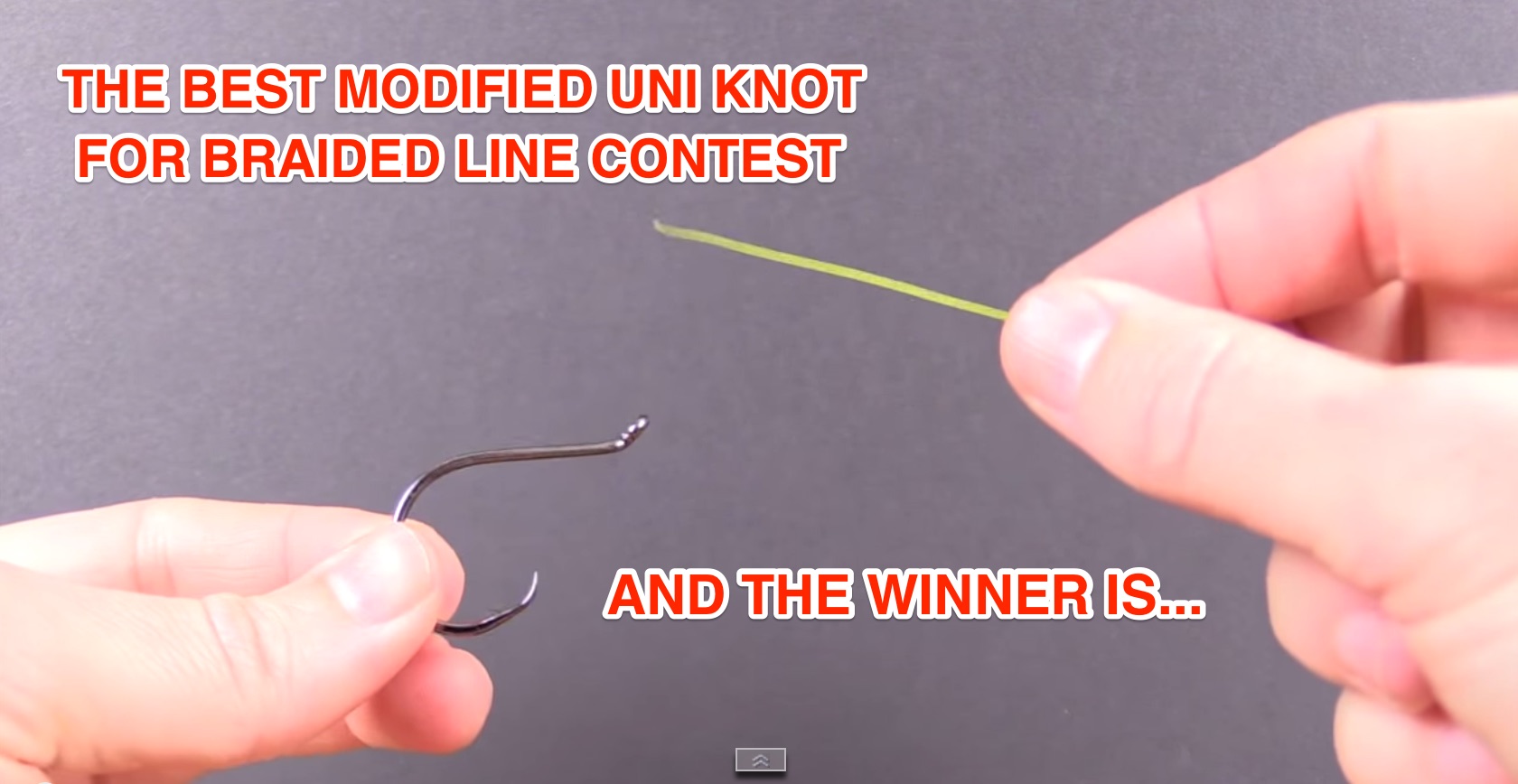The Best Modified Uni Knot for Braid Line [Strength Test Results]
- By: Luke Simonds
- on
- Found In: Fishing Knots, Fishing Tips

Do you want to know the best uni knot for braid fishing line?
So did we.
That is why we decided to do our own tests on modified uni knots for braided line.
But before we reveal the results, let’s talk about the issue at hand so you know exactly why this is so critical to fishing with braid.
The most common problem facing anglers who use braided line is that they use the same fishing knots they learned when using mono.
Why is this a problem? Because many knots that are great with mono are not nearly as good when used with braid given the vast differences in the two line types.
Fortunately, the Uni Knot is one of the most popular knots that performs great with mono as well as braided line.
This is a knot that is very popular given its strength, ease of tying, and it’s ability to be used as a line-to-line knot.
The most commonly taught Uni Knot consists of going through the eye once, making a loop, and then wrapping around/through it 5 times.
However, this is the standard mono style of the Uni Knot, and it may not be quite as effective on braid because braid line does not draw as much friction as mono does… (aka – braided line often requires more wraps to create enough friction to not slip).
So we decided to do some testing to see which style of the Uni has the highest breaking strength when tying a braided line to the eye of a swivel, hook, or lure.
Note: This test is specific only to tying braided line to a swivel, hook, or lure. We personally recommend connecting your braided line directly to a fluorocarbon leader when connecting to your hook/lure in most situations.
Uni Knot Variations
Here’s a quick list of the different styles of the Uni Knot that we tested for its strength on braided line:
- Once through the eye and then 5 twists
- Once through the eye and then 10 twists
- Twice through the eye and then 5 twists
- Twice through the eye and then 10 twists
- Three times through the eye and then 5 twists
- Three times through the eye and then 10 twists
Uni Knot Strength Test Results
Not that surprisingly, we found that increasing the twists always increased the breaking strength of the Uni knot. In every test with the eye loop count consistent, the strength increased as more twists were included.
And although it would have seemed as if adding more loops around the eye of the hook would also increase the knot’s breaking strength, it seems as if the twice version provided the most consistently impressive results.
At times, the triple loop version was the winner, but there were times when that style would weaken itself on the final cinch and I couldn’t find a way to get them to consistently pull together in a way that always improved the knot.
Given the added strength of the second loop through the eye in addition to the extra increase in strength of the additional twists, I now believe that the best uni knot version for braided line tied to a swivel, hook, or lure is going through the eye twice and then using 10 or more twists around/through the loop (test #4 above).
How To Tie The Modified Uni Knot
Here is a quick video showing the modified Uni for braided line tied to an eye of a swivel, hook, or lure.
Note: Adding more twists above the 10 twists shown in the video will increase the knot strength. The only downfall on adding more is that it takes a bit longer to tie and can be more difficult to ensure that all of the twists are going in the same direction without wrapping over one another (I typically use anywhere from 10 to 14 twists depending on how much of a hurry I’m in).
Conclusion
Different lines require different knots in many occasions… especially when the line types in question are as diverse as monofilament compared to braid.
Even further, the amount of wraps most certainly makes a difference too… I noticed a ~10% increase in the breaking strength from the standard style to this modified style of the Uni knot when doing this test.
So be sure that you take some time to ensure that your knots are appropriate for the type of line (mono/braid), as well as the type of connection (line-to-leader/line-to-hook/etc.). And set your drag accordingly to ensure you don’t lose the biggest fish of the day due to line breakage.
Note – This test used 10 lb PowerPro braid tied to the eye of a circle hook. Other line types may very well see different results.
Let us know if you find that any other versions of the Uni Knot have better results on braid… we’re always looking for better/newer options.
Go To Our Knot Testing Homepage [Full Knot Rankings]
Related categories:
STOP WASTING TIME ON THE WATER!
Do what the “SMART ANGLERS” are doing and join the Insider Club.
Here’s what you’ll receive today when you join:
- Weekly fishing reports and TRENDS revealing exactly where you should fish every trip
- Weekly “spot dissection” videos that walk you through all the best spots in your area
- Exclusive fishing tips from the PROS you can’t find anywhere else
- Everything you need to start catching fish more consistently (regardless if you fish out of a boat, kayak, or land).










As someone who has fished mono all his life I don’t think 10# braid makes much sense. The line that came spooled on the new reel I just bought is so limp and so small I can barely see it and my fat fingers have trouble holding it.. I have to wear glasses to have any chance of success tying a knot. After I lose half of the 10# to wind knots I”ll be replacing it with at least 20#
Here’s a helpful tip on preventing wind knots from happening: https://saltstrongdev.wpengine.com/articles/how-to-prevent-wind-knots-while-using-spinning-gear/
Thanks.
Sorry one other test for hooks. Have you guys e er tested the various snelled knots versus each other then take the best and test it against your leading to the hook eye knot i,e. doubled up uni etc
I have not yet tested snelled knots. They are known to be very strong for mono and fluoro lines, so I’m sure they’ll score well in terms of strength.
I did a basic search and looked thru al. The Salt Strong tests for lure swivel knots butvI have not seen where the Berkkey Braid knit has ever been tested. It’s certainly more difficult to tie than a double uni but it’s not overly difficult to tie. I use it for most of my hook and swivel connections unless I need a fixed loop. I do use a high twist count especially with braid. But it has seemed to be a very strong knot.
Would you please test the Berkley Braid knot for braid mono and fluor for hook and swivel attachment up?
I would recommend 8-10 whines for mono/fluoro and 15-20 for braid. If it fails by pulls thru add more whines. Obviously with the double up line thru the hook or swivel eye larger diameter mono/fluro might have issues depending on hook to line size matchup.
I have not yet tried the berkley braid knot. It is very similar to the Trilene knot which performs very well with braid, so I’m sure the bb knot will have a very good strength as well. I’ll add it to my list of knots to test out.
I have a quick question, i read earlier in the post that I should use clear mono on the the leader line because when when braid is tied directly to the lure or hook fish can see it. And on another video i saw on youtube stated that line color doesn’t matter to fish. So my question is do i really need a leader if I’m using braid.
Yes, it is best to use a clear leader because the fish can’t see it nearly as well as braid, and it’s more abrasion resistant than braid too. When people talk about the color of line not being much of a factor, it’s generally referring to the color of the braid not mattering much since the clear leader line is hiding doing it’s job in hiding the fact that line is attached to the potential meal when a fish is tracking it down.
I started using the modified uni. Was using a polamar knot for all my braid. The mod uni has changed my knot failure a lot. Thanks
Glad to see that you’re enjoying this knot!
Oh …I see the single braid uni knot twice through the eye or swivel will be stronger than double braid.
I know this is an ages old video, being new to the inshore thing and I did try to search the question first…but why would you want to tie braid directly to a hook, in other words when or why you be fishing without a leader?
As to the “discussion” below as to who holds the rights to a specific knot; most will figure out that with braid more wraps are needed than in flouro or mono. For a 50# braid bimini I do 40 to 50 twists, 3 half hitches and a fazoli finish
I believe he was just using the hook for an illustration as elsewhere he mentions using this knot for a line to swivel connection.
I believe you said for your braid uni vs braid palomar you said the palomar won the first time and the other four rounds lost so if that is the case i was wondering why
With the palomar did you make sure the main line and tag end weren’t crossed
Also wonder what would happen from one overhand knot
Loop positioning is very important as the knot gets tighter the loop tightens around the knot making stronger and more secure until the line finally breaks
The reason why the Palomar isn’t as good for braid as it is for mono is because braid requires more surface area to get a good hold. The uni knot with more wraps is the way to go if tying to a swivel, hook, or lure.
Try doubling over the braid then going through the hook 1 time and wrapping 5 or 10 or 14 times as you see fit. You will have 3 cuts to trim with 2 pieces left over to toss in the trash when done. The extra braid will increase the friction so you may not need 10 wraps.
I tried that a few years ago… the two consecutive wraps through the eye method beats the doubled line wrap that you described in my testing of the uni knot.
Hi, Luke. Great article. I love all the objective testing. With 30 pound PowerPro original, 30 pound Sufix Performance Braid, and 30 pound Yo-Zuri SuperBraid, I have found the best method (through) testing to be what Tiger said. With the above mentioned braids, you would double the line, pass through hook/swivel eye twice, and then only 5 turns. With these particular lines, I have found these to hold the best when tested. It might be worth your further experimentation to see what works with the lighter braids.
You mention in your article about making sure knots are cinched correctly and don’t twist/get out of sequence etc. Great job pointing that out to folks, as it’s something many people don’t pay attention to. Keep up the great work.
Thanks for sharing the info Brian! How much better did you find the line doubling method to be compared to the single line?